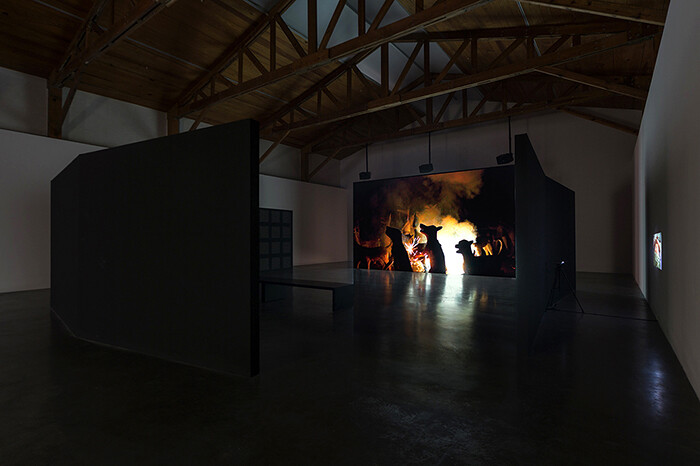Having had the privilege of seeing the work of Apichatpong Weerasethakul in several different contexts (New York, Kassel, and even Bangkok), none have resonated with me so strongly and strangely as that of Mexico; how peculiarly apropos to see his new film in Mexico City. Shown among a furtive constellation of shorter and spatially slighter projections as well as a selection of lightbox photographs, Fireworks (Archives) (2014), the first part of a forthcoming trilogy of films, is clearly the main attraction of the Thai filmmaker and artist’s first solo outing at kurimanzutto.
This 6:40-minute film, which is projected on a large screen at the center of the darkened gallery’s main space, depicts Thai/Lao mystic, cult-leader, and sculptor Bunleua Sulilat’s (1932–1996) temple-cum-sculpture garden, Sala Keoku, located in northern Thailand close to the Mekong River. Passages of blackness sporadically dissolve under the fitful internal illumination of sparklers, which light up to reveal Sulilat’s unorthodox temple populated with a fantastical concrete menagerie of beasts and figures; the sculptures range from the broad, whale-like contours of a frog’s face, to a cavalcade of dogs on mopeds, to a pair of skeletons partially embracing as if sitting for a double portrait. These images are interspersed with those of an older Thai couple mysteriously wandering around the temple like wraiths, the woman’s plodding progress hampered by the use of crutches. Although the occasional volley of machine gun fire is heard, the ambient noise of the sparklers’ crepitations on the soundtrack comes and goes, akin to, but not necessarily in harmony with the flow of images, which sometimes blur and bleed into one another with the gossamer consistency of (cinematic) memory. To say that the film possesses an oneiric quality would be an understatement; the general visual impact is positively ethereal, impressionistic, and fleeting—the way a dream, half remembered, upon waking is, as it flickers obliquely out of consciousness.
Dreaming plays a very important role in Weerasethakul’s work. Deeply mindful of the political marginalization and difficulties among the region in which he grew up, the artist has been known to speculate upon duress and political oppression as productive agents, so to speak, of dreaming in his native country. This preoccupation can be traced throughout the exhibition in such works as the small, stunning projection, One Water (2013), in which the face of Scottish actress Tilda Swinton, eyes closed, blurs in and out of a busy seascape, or, say, The Vapor of Melancholy (2014), a light box photograph capturing the artist’s partner lying in bed with an explosion of fireworks superimposed upon him. Considering all of this within the context of Mexico City, I couldn’t help but wonder how Mexico dreamed. After all, the first thing to come to mind when seeing the temple was English Surrealist poet and collector Edward James’s (1907–1984) Las Pozas, a no less fantastic concrete, sculptural park located several hours north of Mexico City. Meanwhile, the revenant-like figures in the artist’s film could be reminiscent of the phantoms that haunt Mexican author Juan Rulfo’s celebrated 1955 novel Pedro Páramo. Indeed, in terms of cultural sensibility, it was almost as if the film could have been made in Mexico—almost but not quite. Although the sensibilities of Weerasethakul’s Thailand and the cultural context of Mexico seem to be linked, above all, by a kindred proximity to death, the way death functions in each culture seems to be different. For instance, in Thailand, that proximity is marked by a Buddhist belief in reincarnation, whereas in Mexico, it is marked by the hybridity of Catholicism and pre-Hispanic religions, the latter of which involved human sacrifice—hence such improbable saints as Santa Muerte (vernacular Spanish for “Our Lady of the Holy Death”)—and this distinction inevitably informs the way each culture dreams. I also believe that this proximity determines the temporality of a given culture. For example, whereas the past and corresponding ideas of memory seem to play such a significant role in Weerasethakul’s Thailand, the temporality that tends to dominate Mexico is the present (this could be why, for example, everything, from urban planning to aesthetics often feels so ad hoc, so provisional here). That said, seeing Weerasethakul’s film in Mexico City helped me grasp what is essentially a very political quandary: while it is certain that cultures dream differently, it is not certain that all of them dream.









